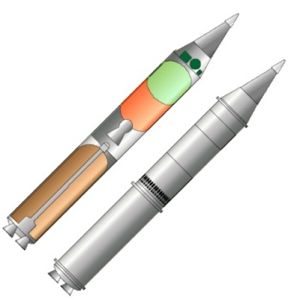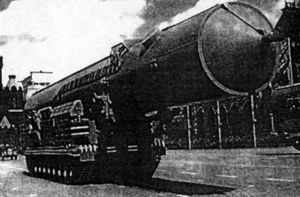RT-20P (original) (raw)

Home - Search - Browse - Alphabetic Index: 0- 1- 2- 3- 4- 5- 6- 7- 8- 9
A- B- C- D- E- F- G- H- I- J- K- L- M- N- O- P- Q- R- S- T- U- V- W- X- Y- Z
RT-20P

RT-20P
Cutaway of RT-20P. Key to cutaway: Orange=UDMH; Green=N2O4; Brown=Solid propellant.
Credit: © Mark Wade
Ukrainian intercontinental ballistic missile. Following the protracted development of Shavyrin's Gnom air-augmented ICBM, it was decided to let Yangel tackle the problem of developing a 30 metric ton gross mass ICBM using more conventional technology. At first a three-stage solid propellant design was considered. But it was found impossible to achieve the launch weight with such an approach. Yangel's solution was to propose the only mixed propulsion ICBM ever developed - a solid propellant first stage, and high performance ampulized storable liquid propellant second stage. The draft project for the missile was completed in December 1964 and a decree to proceed with development was issued on 24 August 1965. Shortly thereafter Shavyrin died and Gnom was cancelled, leaving Yangel's RT-20P the lead project for the mobile ICBM requirement. Designs for silo-launched and submarine-launched versions of the missile were to be developed as well.
AKA: 8K99;Scrooge;SS-15. Status: Retired 1969. First Launch: 1967-10-20. Last Launch: 1969-08-07. Number: 12 . Payload: 545 kg (1,201 lb). Thrust: 600.00 kN (134,880 lbf). Gross mass: 30,200 kg (66,500 lb). Height: 17.80 m (58.30 ft). Diameter: 1.60 m (5.20 ft). Apogee: 1,000 km (600 mi).
The draft project for the mobile-launch system was completed in December 1966.
Yangel's experience with solid propellant motors went back to research begun in November 1960. By 1963 Yangel created a subsidiary, KB-5, at the Pavlograd Mechanical Factory. V M Shkurenko was in charge of the bureau, which began a series of tests on the premises of the factory, leading up to the first large-scale motor test firing in January 1964. In February 1966 KB-5 was reorganized to concentrate exclusively on R&D for solid motors, with the new head V I Kusushkin (who would remain at that position for thirty years). The motor for the RT-20P itself was based on a design originally developed for TsSKB-7 Arsenal's D-6 SLBM. Boris Zhukov developed the four-nozzle motor at NII-125.
The second stage used the RD-857 / 15D12 liquid engine developed at Yuzhnoye's KB-4 by Ivan Ivanov. The motor used the traditional N2O4/UDMH propellants, and was later upgraded to the 15D169 used on the MR-UR-100 ICBM. The stage itself had the unusual designation 8K94, usually used for a stand-alone missile. Perhaps it was originally designed for the same mobile IRBM requirement as Korolev's 8K79.
The mobile version used a T-10M tank chassis from the KB-3 Leningrad Kirov Factory, headed by Zhozef Kotin. A 15P699 launch unit would consist of six of these transporters; one 15N809 position determination and guidance upload vehicle; two 15N1034 marker vehicles to complete determination of launch position; two 15P694 diesel generator vehicles; and a 'Relef' communications vehicle. The launcher vehicle was shown publicly in the big Moscow parade on 7 November 1967 and given multiple designations by Western intelligence agencies - a sure sign of confusion (SS-X-15 / SS-XZ / Scrooge).
A team headed by B G Bochkov at KBEM studied the 15P096 silo-launched system. Two versions of the OS-SM-CP20 launch silo were considered in the 1966 draft project in order to ensure survival of the missile even after near misses by enemy nuclear warheads. One version used a shock attenuation system, the other use of a suspended mounting ring on which the missile rested.
In all versions a 250 kg cold gas cartridge ejected the missile to an altitude of 20 to 30 m before ignition of the first stage. This represented the first use of this technique, later adopted for all Soviet ICBM's. Navigation was by an inertial navigation system using advanced air bearing gyroscopes.
The missile could be fitted with two possible warheads. Three small rocket engines were used for warhead separation. The heavy re-entry vehicle, with a total mass of 1410 kg and a yield of 1.5 MT, was expected to provide an accuracy (CEP) of 2 km at a range of 8,000 km. The light warhead, with a mass of 545 kg and a yield of 550 KT, allowed a 4 km CEP at an 11,000 km range. However by the beginning of the test series, it seemed that these ranges would be only 5,000 and 7,000 km respectively. This made the missile only marginally 'intercontinental', since only targets in the northeast United States (e.g. New York) could be hit with the light warhead from any practical deployment locations in the northwest Soviet Union (e.g. Plesetsk).
Nevertheless development continued and flight trials started at Plesetsk in October 1967. A total of 8 or 12 launches were completed when the project was cancelled in October 1969. The stated reason for the cancellation was unease of the military leadership in having nuclear-tipped missiles rumbling around the countryside.
Stage Data - RT-20P
- Stage 1. 1 x 15D151. Gross Mass: 19,150 kg (42,210 lb). Empty Mass: 2,450 kg (5,400 lb). Thrust (vac): 647.000 kN (145,451 lbf). Isp: 260 sec. Burn time: 65 sec. Isp(sl): 235 sec. Diameter: 1.60 m (5.20 ft). Span: 1.80 m (5.90 ft). Length: 6.12 m (20.07 ft). Propellants: Solid. No Engines: 1. Engine: 15D151. Status: Out of production. Comments: Four nozzles. Length with interstage 9.8 m. Sea level thrust 60,000 kgf. Specific impulse estimated.
- Stage 2. 1 x 8K94. Gross Mass: 9,800 kg (21,600 lb). Empty Mass: 900 kg (1,980 lb). Thrust (vac): 147.000 kN (33,046 lbf). Isp: 330 sec. Burn time: 215 sec. Diameter: 1.60 m (5.20 ft). Span: 1.80 m (5.90 ft). Length: 8.40 m (27.50 ft). Propellants: N2O4/UDMH. No Engines: 1. Engine: RD-857. Status: Development 1962. Comments: Empty mass estimated.
Subtopics
| 8K94 stage N2O4/UDMH propellant rocket stage. Unusual designation for the upper stage of another Yangel project - possibly reflecting that the design originally was a stand-alone IRBM? Empty mass estimated. |
|---|
Family: ICBM, vehicle-launched. Country: Ukraine. Engines: RD-857. Launch Sites: Plesetsk, Plesetsk LC157. Stages: 8K94 stage, 15D151. Agency: Yuzhnoye. Bibliography: 2, 475, 476.
Photo Gallery
 |
RT-20P in MoscowRT-20P mobile launcher paraded in Moscow, 1967. |
|---|
1967 October 20 - . Launch Site: Plesetsk. Launch Complex: Plesetsk LC157. Launch Vehicle: RT-20P. FAILURE: Failure.
1967 November 1 - . Launch Site: Plesetsk. Launch Vehicle: RT-20P.
1968? - . Launch Site: Plesetsk. Launch Vehicle: RT-20P.
1968? - . Launch Site: Plesetsk. Launch Vehicle: RT-20P.
1968 - . Launch Site: Plesetsk. Launch Vehicle: RT-20P. FAILURE: Failure.
1968 - . Launch Site: Plesetsk. Launch Vehicle: RT-20P. FAILURE: Failure.
1968 - . Launch Site: Plesetsk. Launch Vehicle: RT-20P. FAILURE: Failure.
1968? - . Launch Site: Plesetsk. Launch Vehicle: RT-20P.
1968 February 12 - . Launch Site: Plesetsk. Launch Vehicle: RT-20P. FAILURE: Failure.
1969? - . Launch Site: Plesetsk. Launch Vehicle: RT-20P.
1969 - . Launch Site: Plesetsk. Launch Vehicle: RT-20P. FAILURE: Failure.
1969 August 7 - . Launch Site: Plesetsk. Launch Vehicle: RT-20P. FAILURE: Failure.
Home - Search - Browse - Alphabetic Index: 0- 1- 2- 3- 4- 5- 6- 7- 8- 9
A- B- C- D- E- F- G- H- I- J- K- L- M- N- O- P- Q- R- S- T- U- V- W- X- Y- Z
© 1997-2019 Mark Wade - Contact
© / Conditions for Use